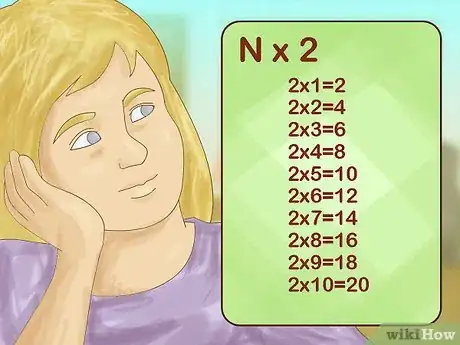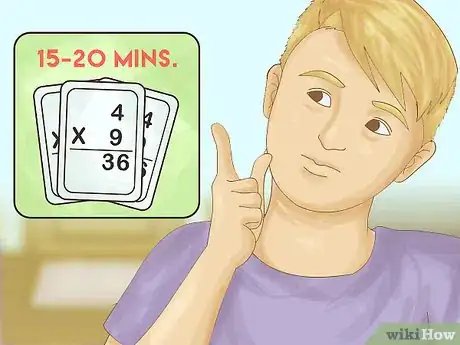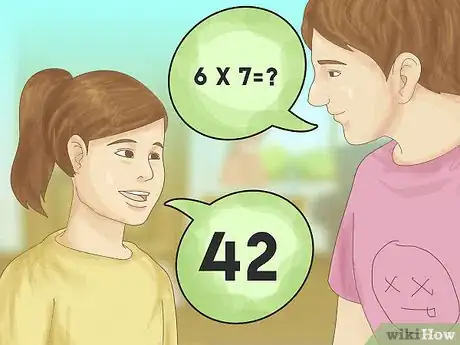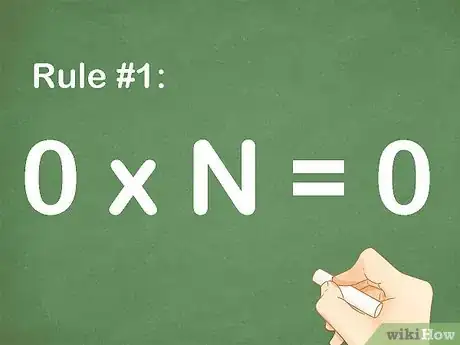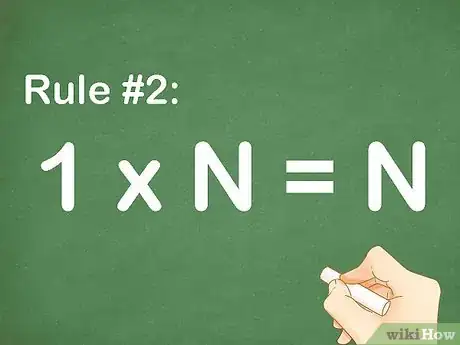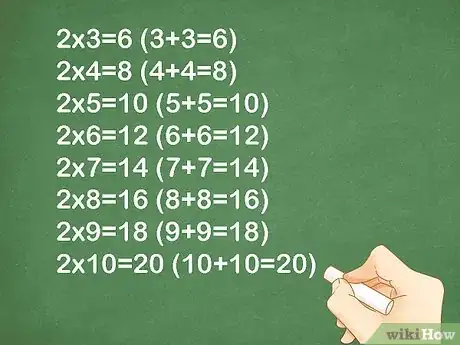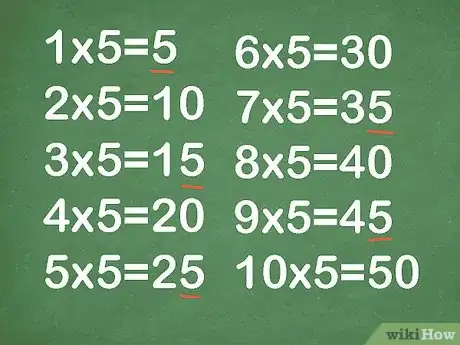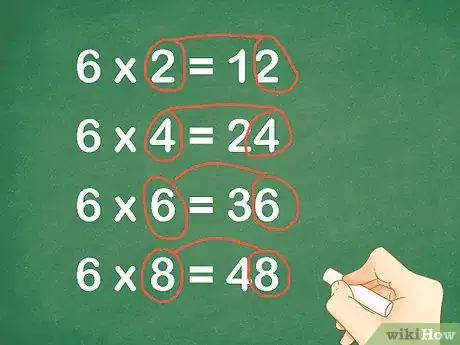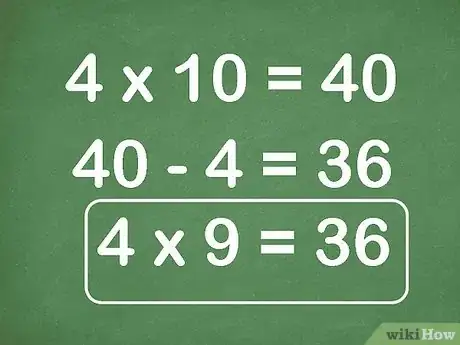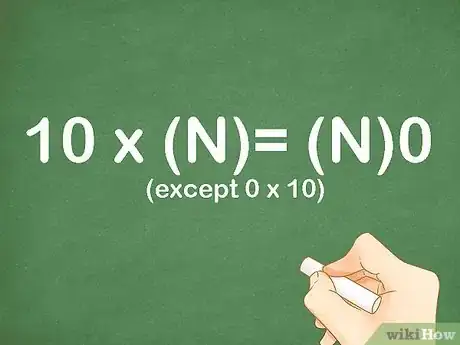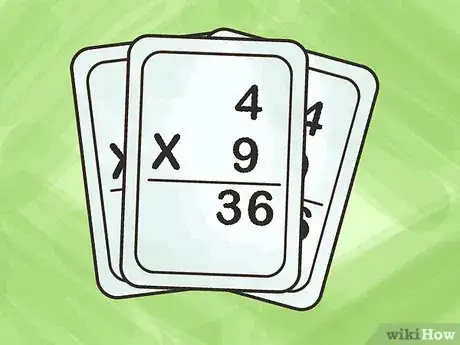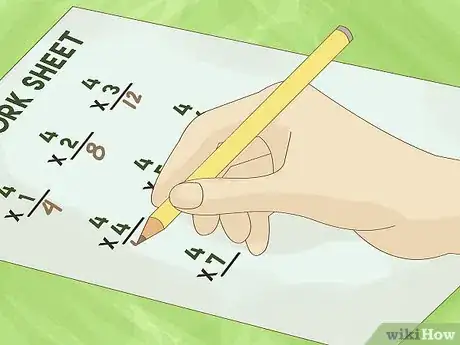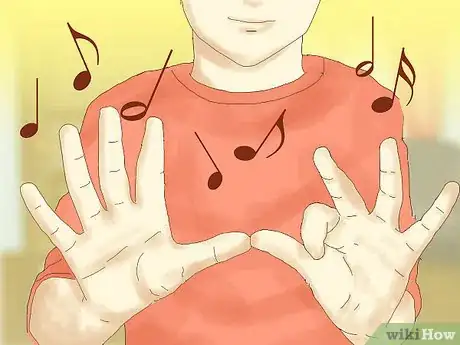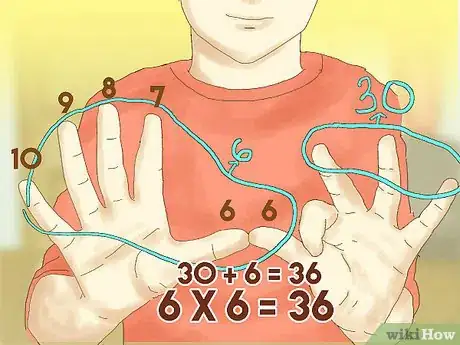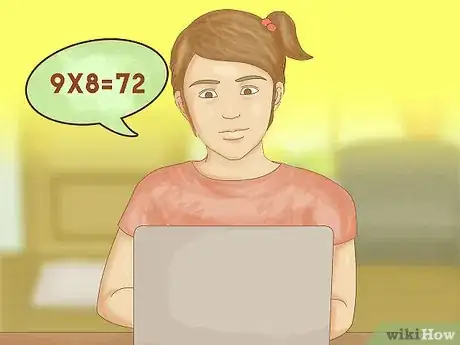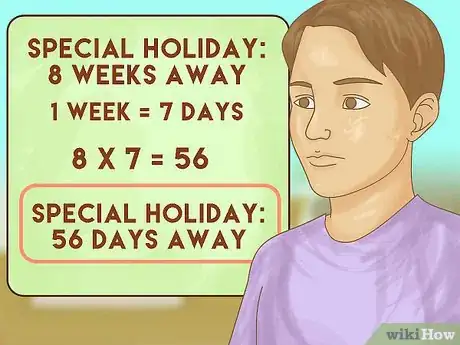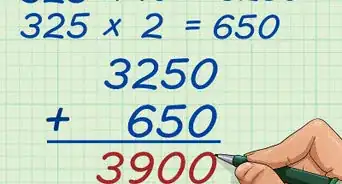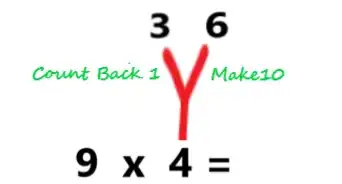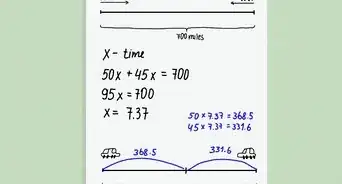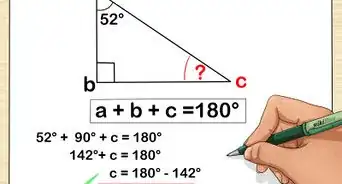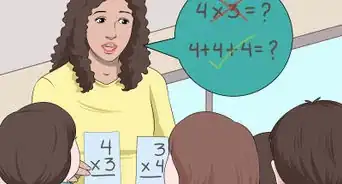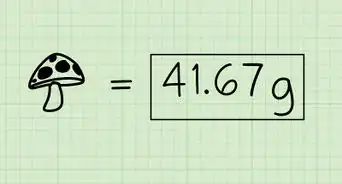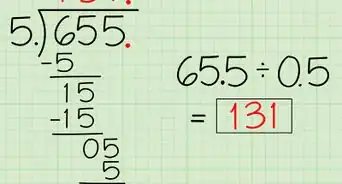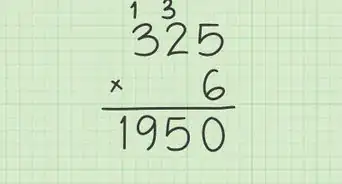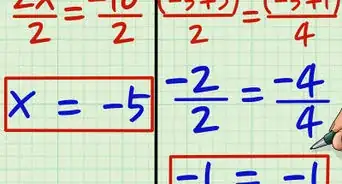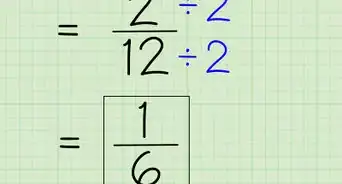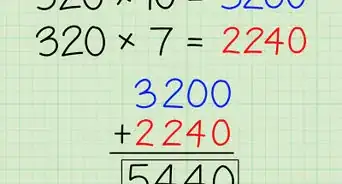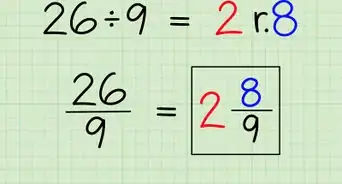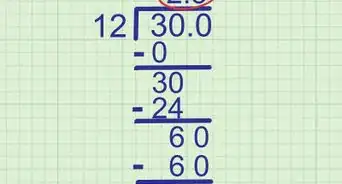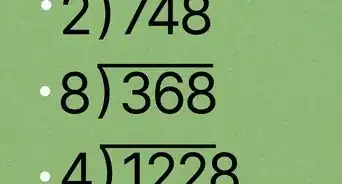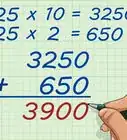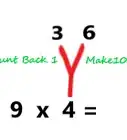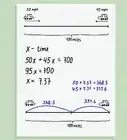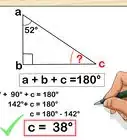This article was co-authored by wikiHow Staff. Our trained team of editors and researchers validate articles for accuracy and comprehensiveness. wikiHow's Content Management Team carefully monitors the work from our editorial staff to ensure that each article is backed by trusted research and meets our high quality standards.
There are 8 references cited in this article, which can be found at the bottom of the page.
wikiHow marks an article as reader-approved once it receives enough positive feedback. In this case, 82% of readers who voted found the article helpful, earning it our reader-approved status.
This article has been viewed 275,920 times.
Learn more...
Learning multiplication facts is an essential part of childhood math. It takes time to learn them, but with a few tips and tricks, you can conquer them with practice. Once you have them memorized, you can work on getting faster with them so that the numbers just come to you. Some of the multiplication facts are simpler than others, but many of them have helpful hints that make them easier to learn.[1]
Steps
Approaching Multiplication Facts
-
1Learn one table at a time. Select one multiplication table to learn at a time. Start with the simple tables such as 2s, 10s, 5s, and 11s. By the time you learn the more difficult tables such as the 7s and 8s, you will already know several facts.[2]
- Remember, 1 x 4 is the same as 4 x 1 so you only have to learn half of the multiplication table because the other half is just written the other way.
-
2Take your time.[3] You don’t need to sit down and learn all of the multiplication facts at one time. In fact, this would be the worst way to learn. Choose a table and focus solely on that one. Take as much time as you need to master each one before moving onto the next one.
- Spend about 15-20 minutes each day studying flashcards or playing math games to master each multiplication fact.
- There are many multiplication math games with different themes that can be found online.[4] For instance, if you really like dinosaurs, find one that uses dinosaurs to make learning more fun.
Advertisement -
3Ask family to quiz you on your multiplication tables. Once you have studied them enough to know them well, ask your family to quiz you on the tables you have just learned. This will help you remember them long term and keep the numbers fresh in your head.
- When you have all the tables memorized, ask them to quiz you on all of the numbers, not just one number at a time.
Learning Some Number Tricks
-
1Know that any number multiplied by 0 is simply 0. The zero multiplication facts are the easiest because every number multiplied by 0 always equals zero.
- For example 0 x 1 = 0, 0 x 5 = 0, 0 x 8 = 0, etc.
-
2Recognize that any number multiplied by 1 is equal to itself. The one multiplication facts are easy to learn because when you multiply a number by 1, it is equal to that number. Remember, zero is the exception to this.
- For example: 1 x 2 = 2, 1 x 4 = 4, 1 x 7 = 7, etc.
-
3Add the number to itself for the 2 table. When learning the multiplication facts for the number two, you may realize that the number being multiplied by 2 is simply added to itself. Instead of memorizing all of the numbers, just add the number to itself and you have learned the multiplication facts for the number two![5]
- For example 2 x 4 = 8, but 4 + 4 = 8.
- The same goes for every other number, 2 x 3 = 6 (3 +3 =6), 2 x 5 = 10 (5 + 5 = 10), etc.
-
4Recognize the pattern for the 5 table. The last digit of the product ends in either a 5 or a 0. The pattern starts with 5 and alternates with 0: 5, 0, 5, 0. For example: 5 x 1 = 5, 5 x 2 = 10, 5 x 3 = 15, 5 x 4 = 20, etc. There are two other tricks to help with the 5 facts as well: the product (1) is always half of 10 times that number and (2) is half the number times 10.[6]
- For example: 5 x 4 = half of (10 x 4). 10 x 4 = 40, half of 40 is 20; 5 x 4 = 20.
- Another example: 5 x 4 = (half of 4) x 10, half of 4 is 2, 2 x 10 = 20; 5 x 4 = 20.
-
5Know that when you multiply an even number by 6, they end in the same digit. A helpful hint for the 6 multiplication facts is knowing the last digit of the product. This trick only works for even numbers. When you multiply 6 by an even number, the last digit of the product will be that number.[7]
- For example: 6 x 2 = 12, 6 x 4 = 24, 6 x 6 = 36, 6 x 8 = 48, etc.
-
6Multiply 10 x the number, then subtract the number for the 9 multiplication facts. A quick trick for learning the 9 table is to multiply the number by 10, then subtract that number from the product for the final answer.[8]
- For example: 9 x 4. First multiply 4 x 10 = 40. Then subtract 4 from 40 to get 36. 9 x 4 = 36.
- Another example: 9 x 8. 10 x 8 = 80, 80 – 8 = 72. 9 x 8 = 72.
- Note the two numbers in the product will add up to 9! For 9 x 4 = 36, 3 + 6 = 9. For 9 x 8 = 72, 7 + 2 = 9. This works for numbers 2 – 9.
-
7Add a zero to the product of any number times 10. When multiplying by 10, the product is equal to the number followed by a 0 at the end. Again, zero is the exception to this rule (0 x 10 = 0).[9]
- For example 10 x 2 = 20, 10 x 7 = 70, 10 x 9 = 90, etc.
-
8Repeat the digit (up to 9) when multiplying by 11. The multiplication facts for 11 are pretty simple until you reach the number 10. Simply repeat the number you are multiplying by for the final answer. After 9, you need to memorize that 11 x 10 is 110, and 11 x 12 is 132.[10]
- For example: 11 x 2 = 22, 11 x 3 = 33, 11 x 4 = 44, etc.
Using Tools to Memorize the Times Tables
-
1Use flashcards. Make multiplication cards for each number set. Although this may seem tedious, the process of making the cards will actually help you to learn them. Once you’ve made them, spend some time each day studying until you know them all.[11]
- Focus on one number set at a time.
- When you go through the cards, put the ones you get wrong back into the pile so you see them multiple times.
-
2Practice with worksheets. Once you have mastered the flash cards, try your hand at some worksheets. Start by practicing with one number set at a time. When you have mastered all of them, try worksheets that mix up all of the number sets and see how you do.[12]
- If you know your tests will be timed in school, try practicing with a timer.
-
3Sing songs with hand movements. There are multiplication albums that sing the times tables. You can listen along and learn the times tables through music instead of rote memorization.[13] Listen to a few different versions and find one that works best for you.
- Add in hand motions or dance moves that illustrate the different number pairs to make the process more interactive.
-
4Use mnemonics and silly stories to help you remember. A mnemonic is a special technique or learning device that helps you remember something. Stories like Times Tales can help you memorize your multiplication facts by associating the numbers with silly characters and stories.
- Phrases like 5 6 7 8, 56 equals 7 times 8 are also useful.[14]
- There are many ways to memorize things, you just need to find the way that works best for you.
-
5Play math games. After mastering all of the fact families, play math games to build up speed. There are many games available online to help you master your fact families and go through them quickly.[15]
- Math games are a more exciting and interactive way for children to learn the multiplication tables.
- Some math games include visual aids and other graphics to help you relate the numbers together.
- Drawing pictures to represent multiplication is another fun way to learn the tables. For 2 x 3, draw three dogs, each with two eyes and count the number of eyes (6 total).
-
6Relate the numbers and multiplication tables to everyday life. Try to find ways to incorporate the math tables into daily life. This will help you truly understand the numbers instead of simply memorizing the material.
- If you know that a special holiday is only 8 weeks away, you can use your multiplication facts to figure out how many days away it is. There are 7 days in a week, so 7 times 8 is 56. Your holiday is only 56 days away!
Community Q&A
-
QuestionAre there any tricks to remember the 4 times table?
 Community AnswerLike the the three times table, there isn't a quick and simple trick, but you can double the two times table for that number to get the four times table. For example, 2 x 6 = 12, 4 x 6 = 24 which is double 12.
Community AnswerLike the the three times table, there isn't a quick and simple trick, but you can double the two times table for that number to get the four times table. For example, 2 x 6 = 12, 4 x 6 = 24 which is double 12. -
QuestionWhat about the three times table?
 Community AnswerThere isn't an easy trick to remembering the threes, but if you have the sixes memorized, the threes will be equal to half of the corresponding six. For example: 6 x 4 = 24, 3 x 4 = 12 which is half of 24. You can also check to make sure the product is part of the three times table by adding up the digits in product. All digit sums should equal 3, 6, 9, or 12. For example, 3 x 4 = 12; 1 + 2 = 3.
Community AnswerThere isn't an easy trick to remembering the threes, but if you have the sixes memorized, the threes will be equal to half of the corresponding six. For example: 6 x 4 = 24, 3 x 4 = 12 which is half of 24. You can also check to make sure the product is part of the three times table by adding up the digits in product. All digit sums should equal 3, 6, 9, or 12. For example, 3 x 4 = 12; 1 + 2 = 3. -
QuestionIs there any tricks for the 8 timetables?
 Community AnswerThere isn't an easy trick to memorizing the 8 tables, but if you use tricks to remember the 7 or 9 tables, you can use addition or subtraction to easily find the 8 tables.
Community AnswerThere isn't an easy trick to memorizing the 8 tables, but if you use tricks to remember the 7 or 9 tables, you can use addition or subtraction to easily find the 8 tables.
Warnings
- Do not use unreliable sources. For example, math games on scratch may have the wrong answer inserted in the source code.⧼thumbs_response⧽
References
- ↑ https://www.mathsisfun.com/multiplication-tips-tricks.html
- ↑ http://process.arts.ac.uk/content/how-learn-your-times-tables-top-tips-and-tricks
- ↑ http://process.arts.ac.uk/content/how-learn-your-times-tables-top-tips-and-tricks
- ↑ http://www.multiplication.com/games/all-games
- ↑ https://www.mathsisfun.com/multiplication-tips-tricks.html
- ↑ https://www.mathsisfun.com/multiplication-tips-tricks.html
- ↑ https://www.mathsisfun.com/multiplication-tips-tricks.html
- ↑ https://www.mathsisfun.com/multiplication-tips-tricks.html
- ↑ https://www.mathsisfun.com/multiplication-tips-tricks.html
- ↑ https://www.mathsisfun.com/multiplication-tips-tricks.html
- ↑ https://www.activityvillage.co.uk/times-tables-flash-cards-double-sided
- ↑ http://www.mathworksheets4kids.com/multiplication-tables.php
- ↑ http://www.homeschoolmath.net/reviews/multiplication_mountain.php
- ↑ http://www.mathmammoth.com/lessons/multiplication_tables.php
- ↑ http://www.topmarks.co.uk/maths-games/7-11-years/times-tables
About This Article
To learn multiplication facts, start by memorizing the simplest multiplication tables, like the twos, fives, tens, and elevens, which will help you recognize different patterns and tricks. You can also use flashcards and online math games to help you learn multiplication facts. After you learn a few multiplication tables, ask a family member to quiz you on them so you remember them better. Also, try to memorize number tricks, like how any number multiplied by 1 is itself, which will help you work faster when you're practicing. If you want to learn how to make practice worksheets to help you remember multiplication tricks, keep reading the article!
